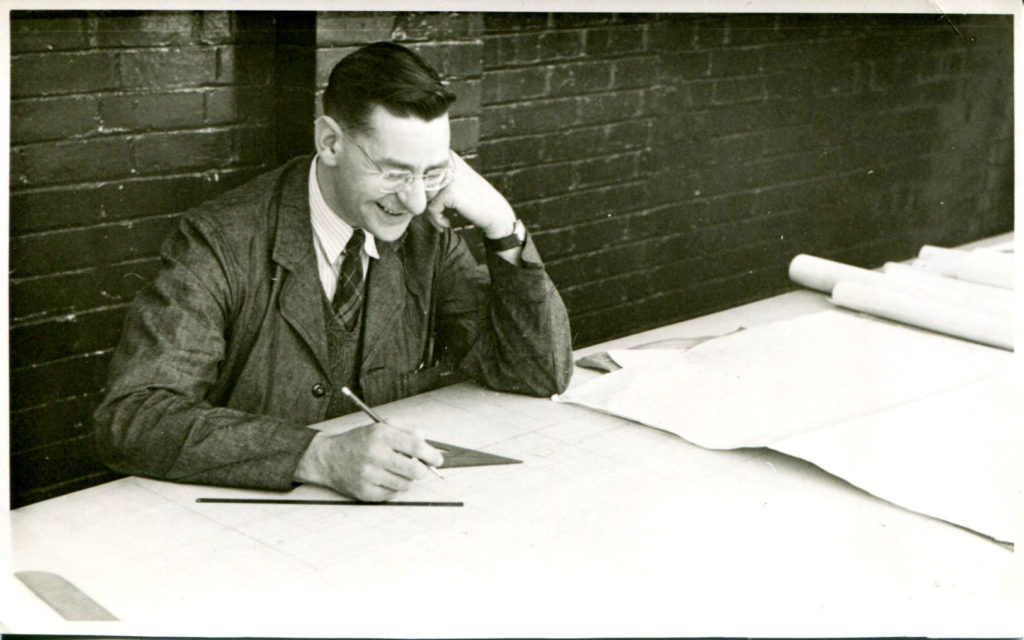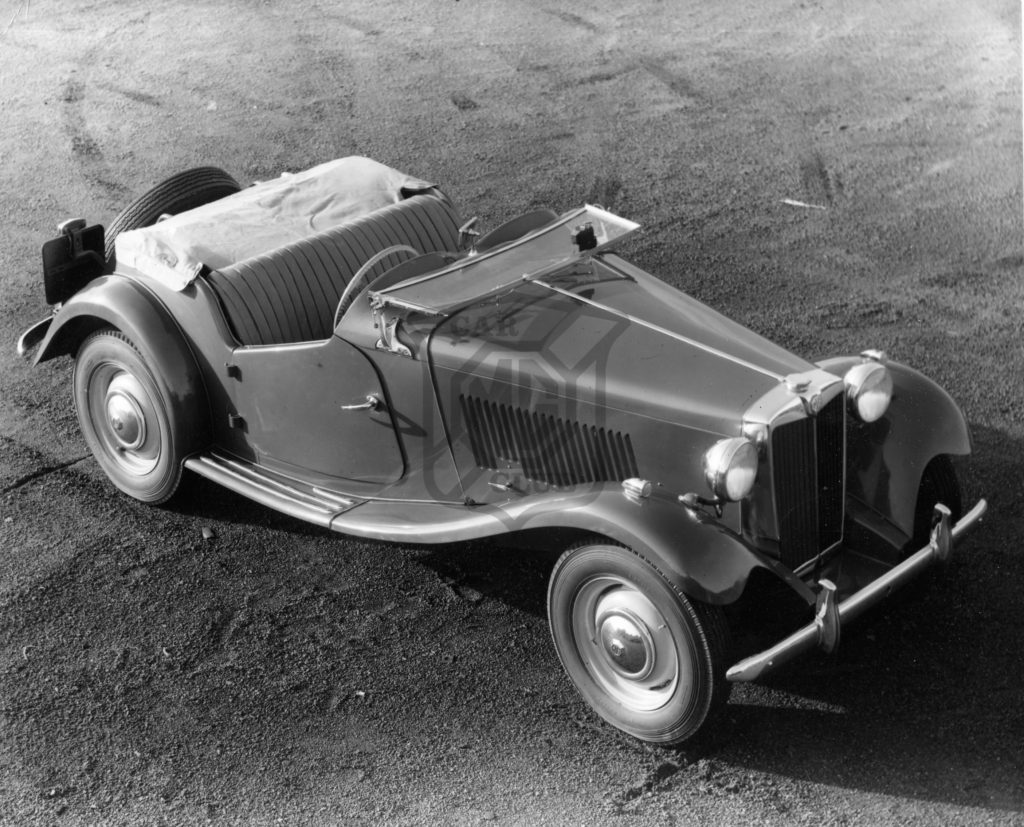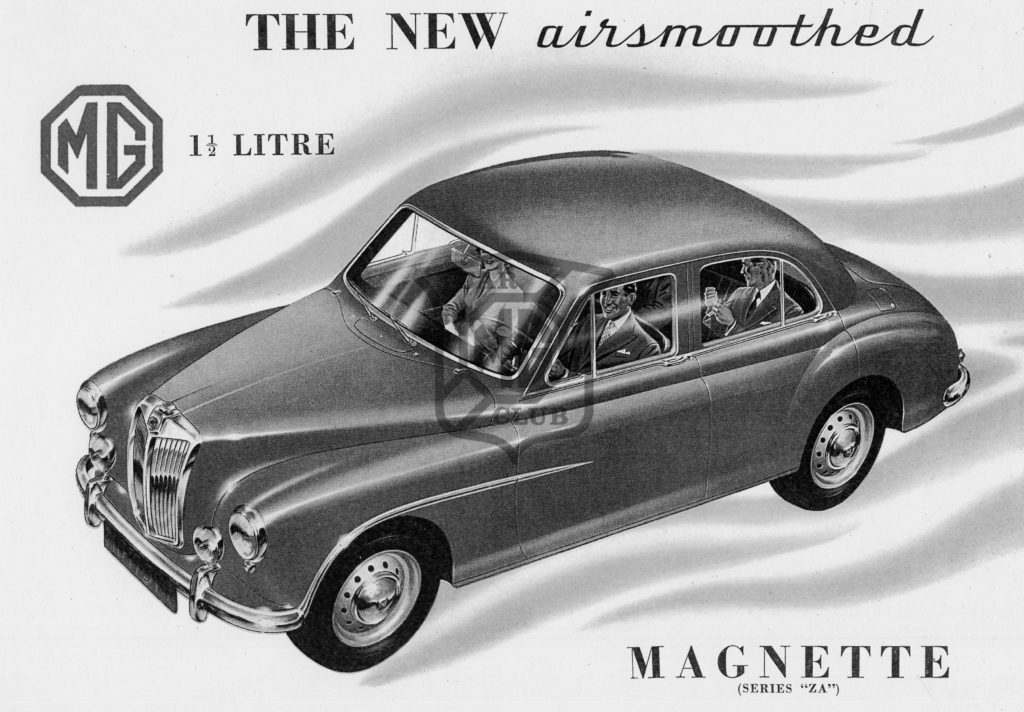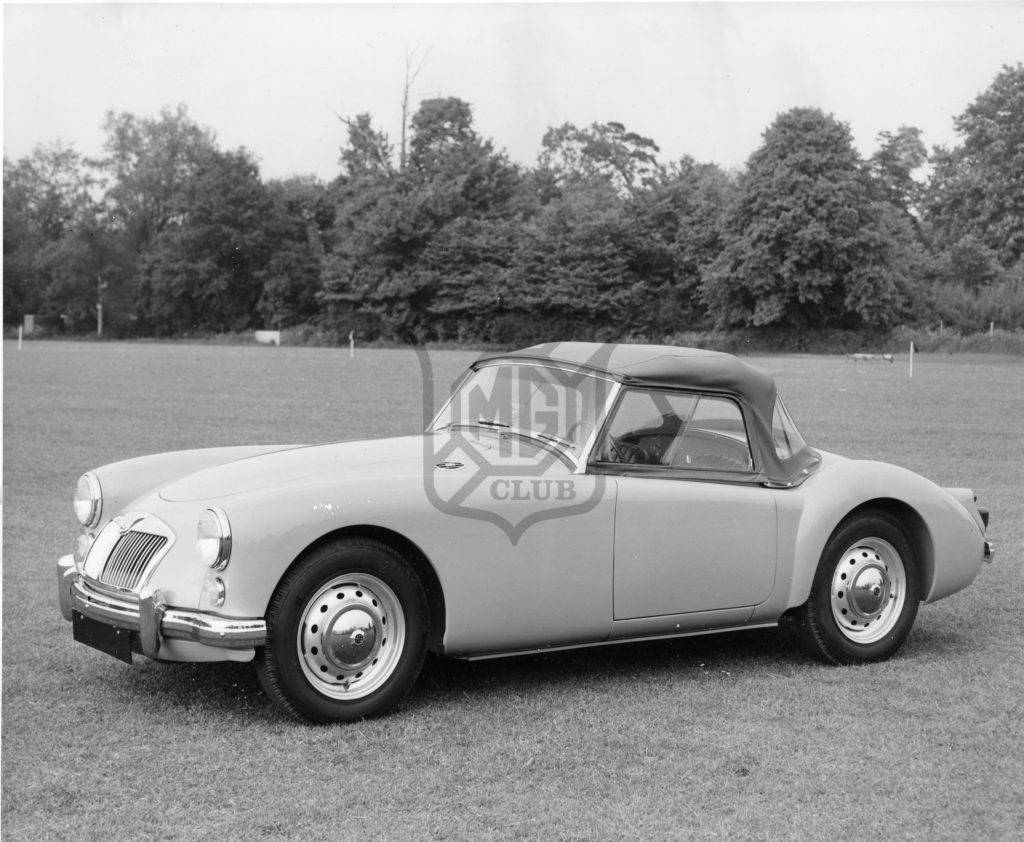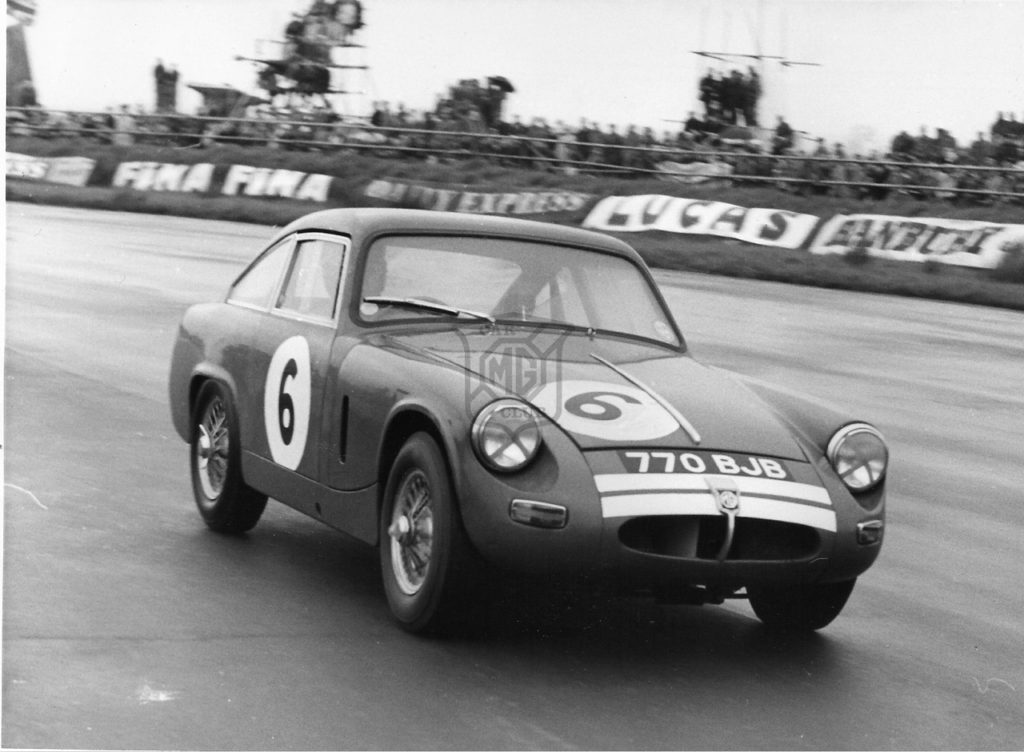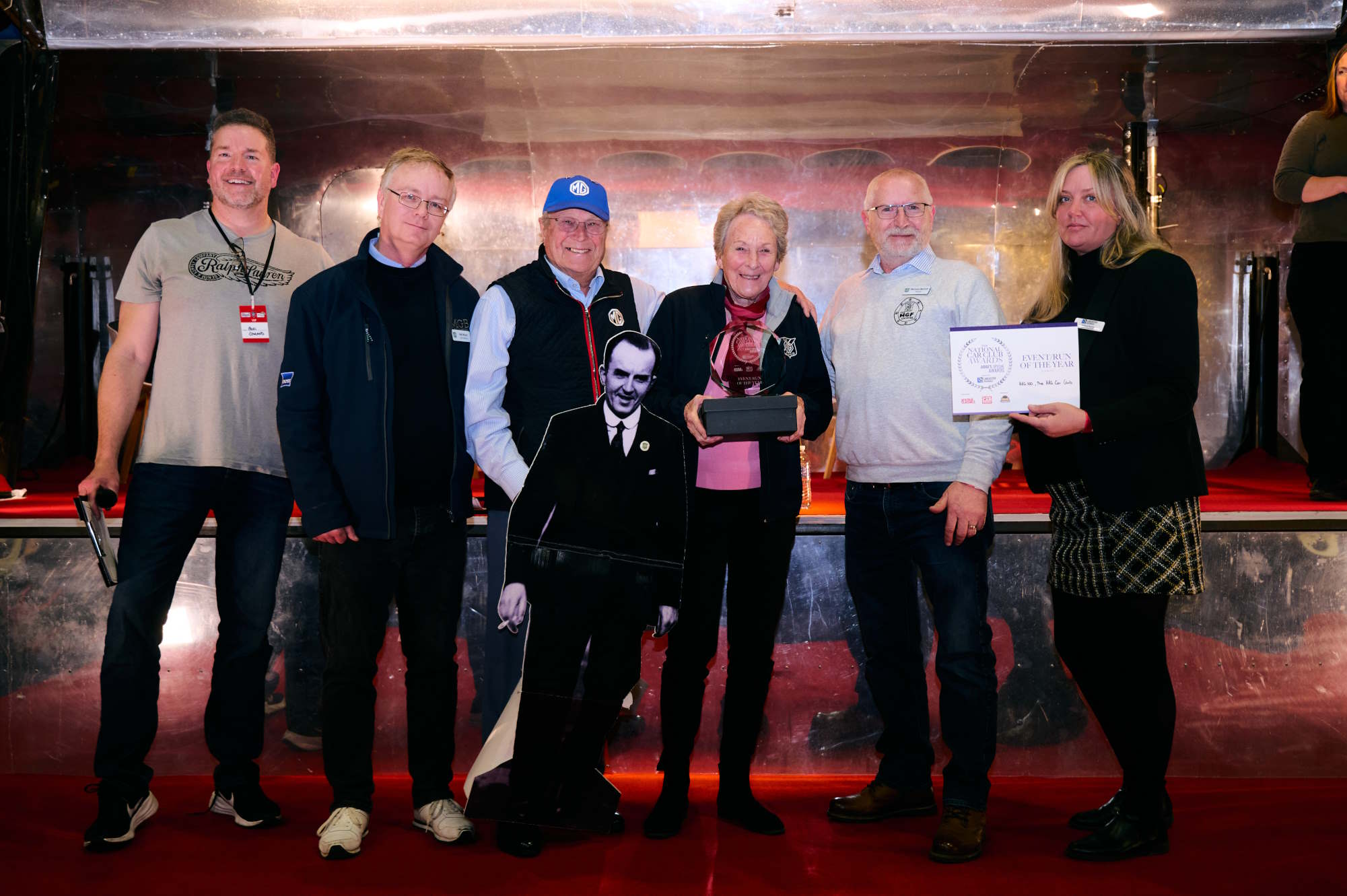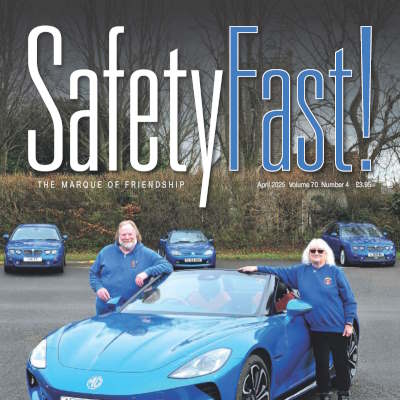Working inside the Octagon
Reproduction in whole or in part of any article published on this website is prohibited without written permission of The MG Car Club.
James Edward O’Neill held the position of Chief Body Designer at the MG Car Company from 1954 when the Abingdon design office was re-established, until the closure of the factory in 1980.
Sadly Jim O’Neill passed away in December 2015 at the age of 93. In 1994 David Knowles met up with Jim and his subsequent interview was published in Safety Fast!. Here is that fascinating article in full.
Jim held the position of Chief Body Designer at the MG Car Company from 1954 when the Abingdon design office was re-established, until the closure of the factory in 1980. Jim’s association with MGs however began whilst working at Morris Motors in the 1940s. His first MG job was to design a new body for what would become the TD Midget. This led to him being selected to join Gerald Palmer as his chief body draughtsman in the new MG design office that Palmer had set up on his return to Morris Motors from Jowett. This office eventually absorbed both Riley and Wolseley.
Memories of my career with MG
I started my automobile career in 1936 when I joined the Pressed Steel Co., which later became the Cowley Body Plant for the Rover Group. The Pressed Steel Co. were always regarded as a good training ground for young engineers due to the various models for different customers. Hillman, Standard and Morris to name but a few.
The basic design was, of course, the customer’s, but as very expensive tooling was involved, all the bodies were drawn out again on 18 foot drafts with great accuracy laying in Highlight lines at various angles to prove the body shape. All this work now is no longer necessary as the shape of the stylist clay model is recorded electronically onto tape which can then be used for tool machining and to produce detail drawings.
After working for 18 months in the Die Machine Shop I moved to the Drawing Office. My first job there was detailing two small brackets for an MG Car. Little did I realise then that most of my future career would be with the MG Car Co., rising to the position of Chief Body Designer. In 1940 I was transferred to Morris Motors at Cowley to work on various War Time products.
By the end of the war Alec Issigonis had designed a new car, ‘the Mosquito’, but before going into production it was widened by four inches to become the Morris Minor. I think the decision by the Technical director, Victor Oaks, to increase the width of the vehicle already so advanced tooling wise was a very courageous one, but he was right. It would have been a very narrow gutted looking car if left as ‘Issi’ had designed it. My contribution to the Minor was detailing the major body panels.
In 1948 I felt I had to extend my experience, moving up to The Austin Motor Co. at Longbridge. We had an exciting programme, or so we thought at the time. Dick Burzie, the Austin Stylist had produced a very attractive small coloured drawing of a convertible which was planned for the American market, hence the name ‘Atlantic’.
The system Austins used to create their layouts differed to the one I had normally been used to, namely the A scale layouts. Austins used large vertical boards and onto these was drawn a thick blue line representing the outline as near as possible to the Stylist’s drawing. One could then stand back 15 feet or so to see how small adjustments could be made to make the perfect line.
It was at one of these sessions that Leonard Lord, the Chairman, appeared and decided he would have a go. So with a ‘let the dog see the rabbit’ he picked up a sweep and proceeded to re-draw part of the line. We stood back to view, I looked at him, he grinned and said, “I’ve mucked it up” (or words to that effect), “you had better carry on”. I mention this incident to show how, in those days, the top man would show a keen interest in what his men were doing. I am afraid it does not happen any more.
George Abbott was the section leader for the layout of this job, with Ken Taylor working on the front end and myself on the rear end. Nobody was more surprised than me when all the body lines joined perfectly over the door area.
After 12 months or so, financial reasons forced me back to Morris Motors. I was sorry to leave Austins as I was very happy there. Morris were extremely busy designing their Morris and Wolseley range of vehicles which was fortunate for me because they had just received instructions to produce a replacement for the MG TC Midget. This was given to me. My brief was to produce a body shape less angular than the TC and more squat. The suspension was based on the 1 ¼ saloon with the chassis design carried out by Jack Daniels. This model was ultimately known as the MG TD. The powers that be were so concerned with the Morris and Wolseley vehicles that nobody in authority ever came to enquire how the layout was progressing. I concluded that Morris Motors were just not interested in MG.
When the body layout was almost complete I was informed that the MG Service Manager would be arriving to have a quick look at what we had planned for them. This was the first time I had met John Thornley and he impressed me with his alert sense of awareness. I do not know how much he understood when looking at the complicated lines of the Body Layout, but he made a point of asking if we could lower the tonneau line by half an inch. This would reduce the height above the rear wing and give an even more squat appearance. I did this while he was still there and sure enough it improved the shape considerably. With a “Leave to go, Sir” he departed. Here at last was somebody who was taking an interest in what I was trying to do.
The completed layout was shipped to our Bodies Branch at Coventry who produced a prototype body, it looked good. The body was mounted onto the Chassis and road proving commenced. The first Road Test Report stated handling good, impossible to read instruments at any speed. I was devastated, what should a young 28 year old designer do to overcome this problem. I had no idea. I have said that none of the Morris personnel were at all interested in the MG but one man now did come to my assistance, namely Tom Ramsay. He was the Assistant Chief Body Draughtsman. His idea was to weld a 1/8 thick steel sheet vertically to the chassis reaching up to the top of the body dash. A 12 inch square hole was then cut in it to enable the driver’s feet to pass to reach the pedals. It cured the scuttle shake. I am sure these days one would never expect a test driver to work under such conditions. The production answer to the sheet of steel was a tubular ‘Goal Post’ welded to the chassis frame. Production of the TD was started early in 1950 and was continued for about three and a half years. When sales dropped Abingdon was forced to ‘Knife and Fork’ the TD by sloping the radiator and lowering the bonnet. This produced a more sleek and angular line, which of course, meant MGs were moving back and not forward. This model became the TF.
In 1949 the Riley Design Office was moved from Coventry to Cowley and the production of Rileys to Abingdon, with Riley’s Jack Tatlow becoming General Manager of the Abingdon Plant. It was about this time that Gerry Palmer returned to Morris Motors from Jowett and was asked to set up a separate Design Office for MG. I was glad to join Gerry, taking charge of the Body Design with Bob Shirley running the Chassis side. The few Riley Designers that had moved to Cowley gradually drifted back to Coventry leaving only the Chief Engineer, Mr Lush (or maybe it was Rush). He was involved in a tragic fatal accident returning home on Christmas Eve. This sad event meant that Gerry and his team were now responsible for both the MG and Riley design.
Gerry’s first design was a very imaginative MG two seater. It consisted of a basic body that could be sold in three versions: Cycle type wings for Hill Climbs etc., Wings and Running Board similar to the TD, or a complete streamlined envelope side. I have no idea why this design was not approved for production, perhaps it was too advanced for its time. Following this disappointment work was started on the layout of replacement versions for 1 1/2 and 2 1/2 Rileys. I was ably assisted by Denis Williams who had joined us from the Morris Team.
Attached to the Design Office was a viewing studio where the Board of Directors could view all the models and it was here that a full size wooden mock-up of our Riley was presented for inspection. It so happened that Lord Nuffield was handing over the Chairmanship to Leonard Lord on this day. During the viewing Lord Nuffield asked me where the Radiator Filler Cap was. I explained that it was on the Header Tank under the bonnet which gave the Radiator Grille a nice clean line. He insisted he wanted it on the top like a traditional Radiator. We hurriedly mounted a cap on some clay and yes, he thought that was fine. The next week, with Lord Nuffield officially retired, I asked Gerry if we could throw the cap away, he smiled and said “if you want to” so out it went. A few days later we heard a great tirade coming from the studio next door, and amongst the ‘sailors language’ we could make out “where is it”. Denis Williams whispered – “… it’s Nuff, he’s looking for his Filler Cap…” The unfortunate person on the receiving end of all this was the studio cleaner, who of course had no idea what Lord Nuffield was upset about, and the blank look from the cleaner was making him even more angry. I had to do some quick thinking on my way round to the studio. As soon as I entered the studio the same questions was asked, “Where is it?” To my eternal shame I had to lie and say, “Oh I have taken it off to draw up.” He immediately calmed down and I think he was even a bit ashamed of himself for causing such a fuss. For anyone who knew Lord Nuffield, when in this frame of mind he could have easily sacked the lot of us and closed the department down. The model was approved for production complete with its exterior Filler Cap which we were able to use as a bonnet safety catch release. The model of course was the Riley Pathfinder.
During this time Gerry Palmer had been busy designing the MG Magnette saloon. He presented me with one of the most detailed 1/4 scale drawings that I have seen. The Engine and suspension was minutely detailed complete with Body sections. This made laying out the full size so much easier. It was planned that the MG would be a derivative of the Wolseley 4/44 and many still think this is so, but of course, the opposite is true. Issigonis was so busy on his other models that in the end Palmer said to me, “We cannot wait any longer, this will be the Magnette and the Wolseley can be raised two inches with a special Radiator Grille to give the gentlemanly appearance required by Sales.” It was Cowley’s decision to put the Wolseley 4/44 into production before the Magnette which led to many people thinking that the MG was developed from the 4/44.
In 1951 George Phillips entered a rebodied TD in the Le Mans 24 hour race. This closely resembled the future MGA. At this time the idea of a future MGA was turned down by Leonard Lord as he had already collaborated with Donald Healey to build an Austin Healey 100 at Longbridge. Clearly Abingdon were far too slow off the mark in not showing the Phillips car to Leonard Lord earlier. I was told later that he may not have considered the Healey project if he had known that this prototype was already in existence in his own group. But who knows, we may have then been denied the exciting experiences of the rallying Healey 3000 and the future Sprites and Midgets.
In the summer of 1954 MG decided that it would be beneficial to have their own design team at Abingdon. Gerry Palmer had been promoted to Technical Director of all design at Cowley which meant that the MG design team was moved back into the main Morris drawing office. I think perhaps John Thornley could see a repeat of the problems we had had with the TD. I approached Syd Enever, who was to become the new Chief Engineer, and arranged for a small team of engineers to move from Cowley to Abingdon.
With a complete change of heart it now appeared that Abingdon would become the Sports Car Division of B.M.C. I do not know for sure, but suspect this was due mainly to the efforts of John Thornley.
Our first task was to beg, borrow or steal as much equipment as possible. Two 18 foot layout tables were made up by the works carpenters, improvised wooden sweeps also made up in the carpenters’ shop. Drawing boards were ‘borrowed’ from Morris Motors.
It was now all systems go to start work on the new MGA, redesigning the Phillips car by repositioning the chassis side members so that the driver and passenger could sit inside the chassis frame thus reducing the body height and the frontal area. On completing the 1/4 scale I joined Eric Carter at our Bodies Branch in Coventry to work on the full scale layout. This meant staying at a local hostelry for a few months and working long hours to get this car into production. We were fortunate to be able to have on loan from Morris Motors a young draughtsman who did all the detail drawings required by the Coventry plant. A magnificent effort by Don Butler.
In the meantime Abingdon were producing the Healey 3000, the production of which had been transferred from Longbridge. The completely trimmed and painted body was shipped by road from Jensen where Eric Neale was responsible for the production design.
My brief, to look after the build at the Abingdon end and liaise with Jensen.
It followed that the Healey Sprite, which was due for production at Longbridge, should now come to Abingdon. Longbridge had given Engineering Sign-off but due to the rather unusual quarter eliptic springs on the rear suspension Syd Enever decided to give the car the usual MG Pave test. It was found that a certain amount of extra reinforcement around the Heelboard area was required. Brackets were quickly produced, virtually over the weekend, by Barrett Engineering, a firm always ready to help us out in an emergency. Body shells already made up were modified and production commenced.
With the MGA in full production it was time to start thinking of its replacement. During a visit to the Geneva Motor Show, Syd Enever handed to me a scrap of paper with a very crude sketch of the future MGB. He wanted the Headlamps set into scollops in the wings and in the flattish area between the headlamps an elongated traditional MG Radiator. The body sides would have a similar rounded section the Jaguar E Type. On our return to Abingdon I drew up the 1/4 size model using as many existing components as possible to save cost. I remember using the Austin A40 Tail Lamps and a Ford bumper section which they agreed we could use provided we paid half the tooling cost. When completed this model looked very dumpy, mainly due to its short wheelbase. I called it the ‘PIG’. Its very rounded sides had to go. With all the additional Healey work at Abingdon it was obvious that more design personnel would be required. I particularly wanted a senior layout man to work on the MGB. We engaged Don Hayter, being sure he would make a useful team member.
Although the demise of the ‘Frog Eyed’ Sprite was mourned by many, it also had its critics. Donald Healey felt it was right to produce a prototype with the headlamps mounted in the wings. At the same time it was decided that we should design an MG. Midget based on the Sprite underframe. It would be slightly up market with a trunk lid and a more conventional Bonnet. The fitting of the large rubber mat into the trunk compartment of the Sprite was a very hazardous operation owing to the toxicity of the adhesive. The operators had to wear a mask which was fed with a fresh air line before climbing into the back of the vehicle, making them appear more like a deep sea diver than a car production worker. The operation was slow and cumbersome and obviously expensive. This cost, however, could be balanced against the additional expense of a Midget trunk lid, making the overall cost more feasible.
When Donald Healey viewed the facelift Sprite alongside the new Midget he insisted that the Sprite be similar to the MG with badge and radiator grille changes. As the MG would be using the Sprite under-frame, and royalties would be paid to Healey, we had no option but to comply with this request. It would however have been an interesting experiment to see how these two vehicles would have fared in the market place. Denis Williams was the Section Leader responsible for laying out the full size Sprite and Midget and seeing the cars into production.
With the production figures of the MGA beginning to fall and with the MGB still a year or two away. a Coupe version of the MGA was sanctioned. We were fortunate in having at our Bodies Branch in Coventry a very able body engineer, Eric Carter. He had the job of designing and producing the prototype Coupe. I remember going to Coventry with John Thornley and Syd Enever to view the car. At the time I felt that it was too round and lumpy and told Eric so. He informed me that production tooling was already underway although the cost had not been cleared, and implored me not to ‘rock the boat’. In retrospect I am sure that the MGA Coupe is a ‘Classic’ shape.
Apart from the production vehicles that we are all well aware of, the office was engaged on many other projects, some getting only as far as a 1/4 scale model or a full size wooden mock-up, others developing into road cars.
Meeting the new American regulations that emerged as a result of Nader’s infamous book proved to be most difficult and time consuming. Most of the regulations were framed around the large American cars, the height of bumpers a typical example. This resulted in the much criticised ‘rubber’ bumper fitted to the later MGBs and Midgets. Bear in mind that at 5mph impacts, no damage was permitted on any component and that even included cracked lamp lenses. As our major market was the U.S.A., failure to meet any of these regulations would have meant that MG ceased trading. There were occasions when the American manufacturers themselves could not meet their own regulations 100%. A case in point, a regulation which required seat belts of driver and any passengers in the vehicle to be fastened before the car could be driven. Peter Neal, who was now responsible for our electrical design, developed an ingenious system of seat pressure pads and seat belt switches working through a black box to comply with the regulations. The American manufacturers had so many problems complying with this regulation that they took their own government to court, won their case and had the regulation removed. Consequently several hundred of our cars already in the States had to be re-worked to remove the system.
In 1980 we were all very saddened when the powers that be decided to close MG at Abingdon and a first class design team was lost forever. The reasoning behind this questionable decision did not appear to any of the team to be valid.

 MG Car Club
MG Car Club